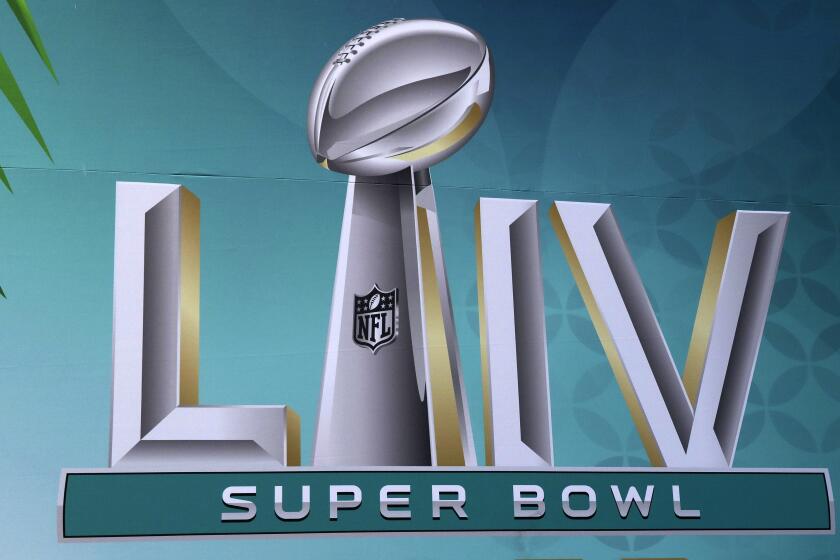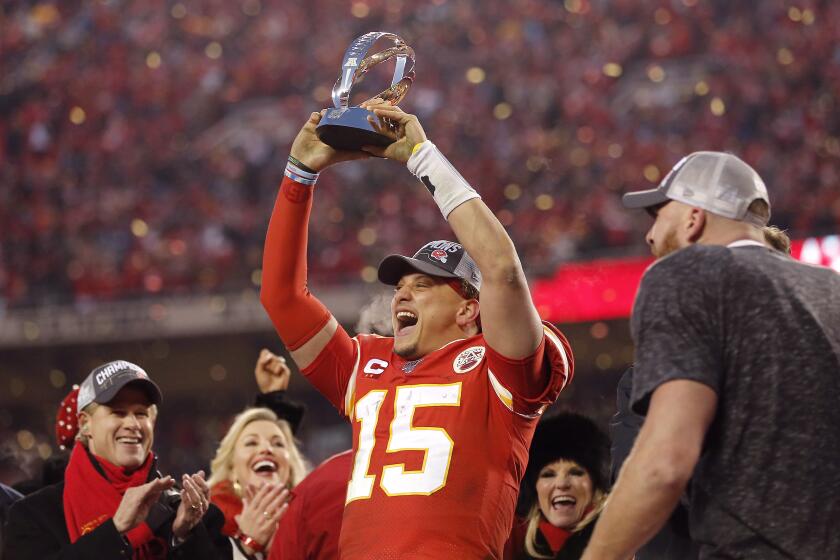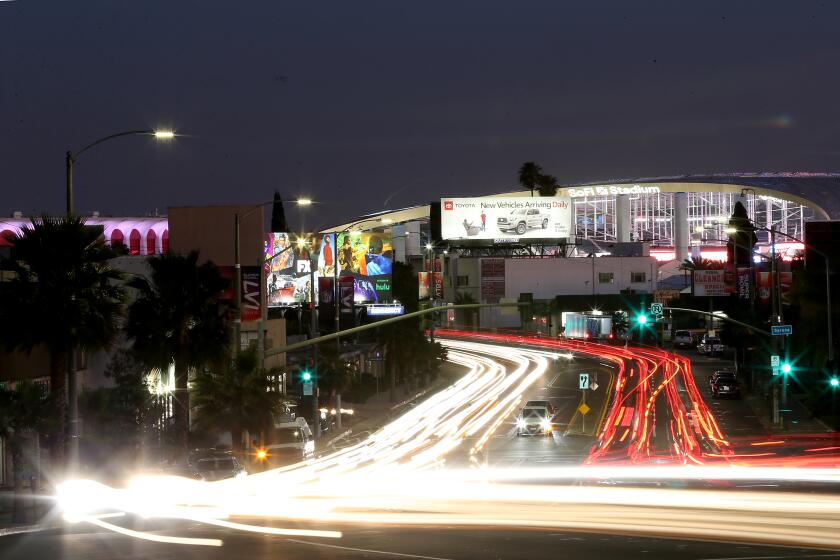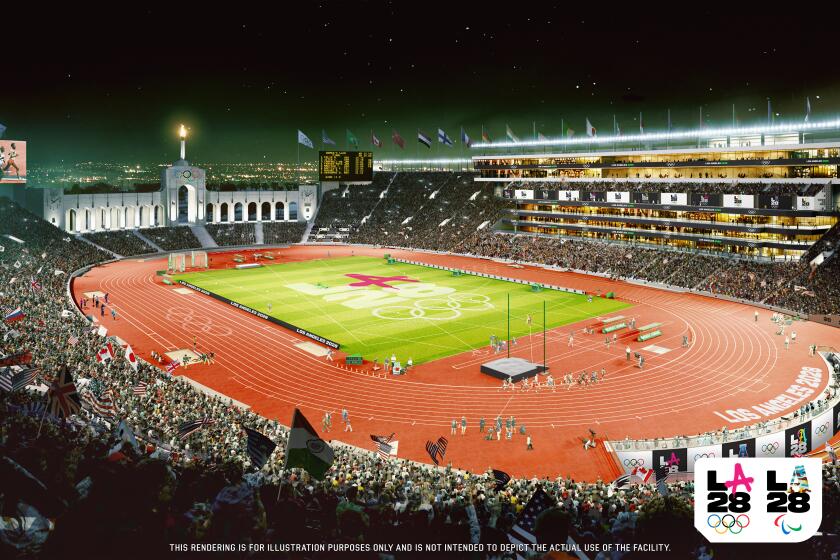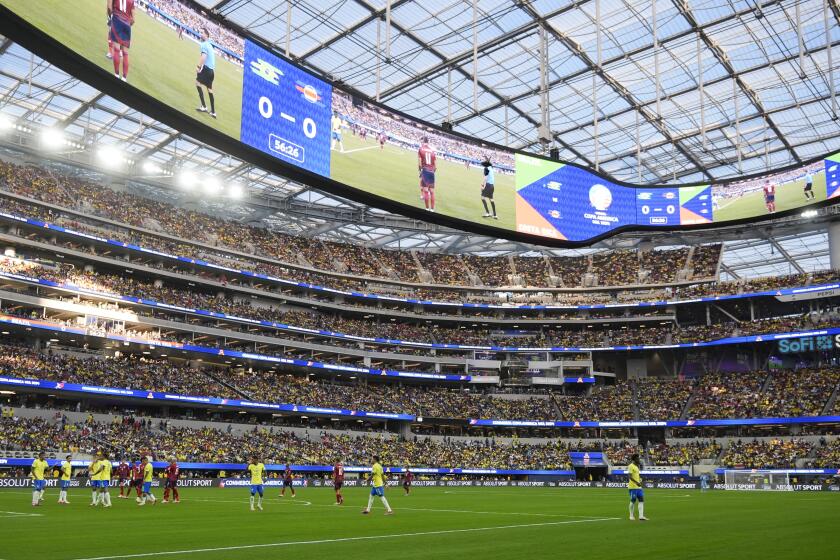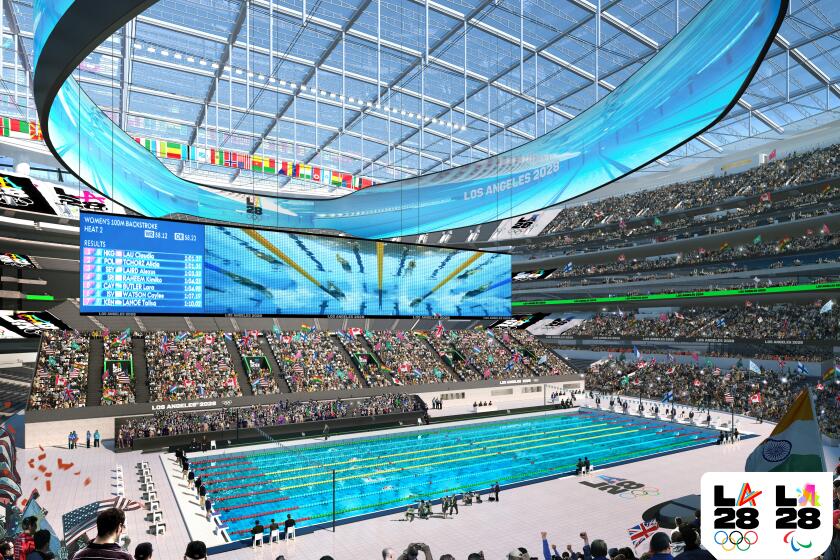SoFi Stadium rises to a new level as Inglewood prepares for its impact
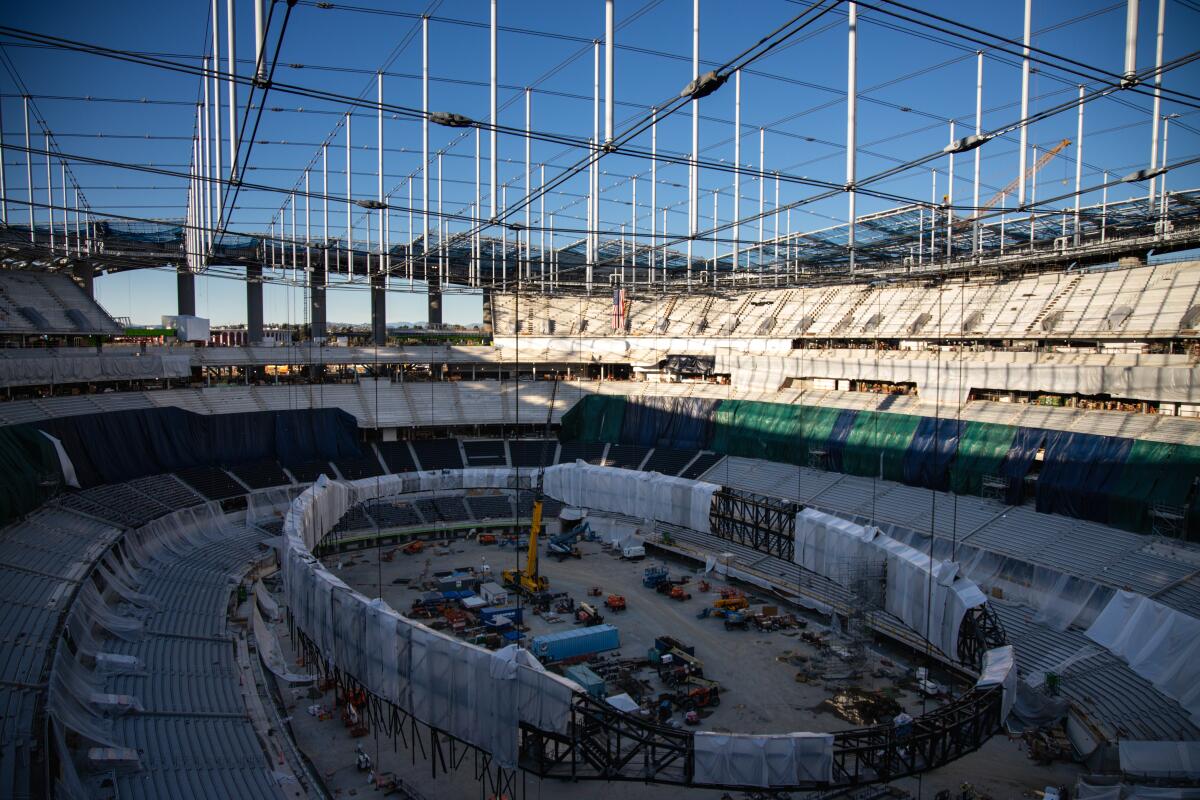
The freight elevator rises slowly, climbing to the top level at SoFi Stadium. This is the part of the new NFL venue, under construction in Inglewood, where Kevin Demoff gets excited.
The Rams chief operating officer ushers his guests past machinery and stacks of building materials to the outer railing, where the panorama on a breezy winter afternoon stretches from Rancho Palos Verdes northwest toward Malibu.
“These views make this building so uniquely L.A.,” he says.
Next, like a homeowner showing off a new addition, Demoff leads everyone inside the bowl. The stands rise steeply on all sides, far more vertical than at the Coliseum.
“You’re right on top of the field,” he says.
The new, 70,000-seat home of the Rams and Chargers is 85% complete and on schedule to open with a Taylor Swift concert in late July. At an estimated cost of $5 billion, it ranks as the priciest venue — by far — in NFL history.
Critics have voiced concerns about the venue and its surrounding Hollywood Park development, a commercial and residential array that will encompass 298 acres, more than three times the size of Disneyland. They worry about its impact on a community that stands among the last African American enclaves in California.
No such concerns entered the conversation as Demoff recently took a group of season-ticket holders on a tour to hear their feedback. The talk centered on construction progress, high-tech features and Sunday afternoons next fall.
“We’ll get some things right, we’ll get some things wrong,” he told them. “But we want to be good listeners and we’ll take risks and try things.”
::
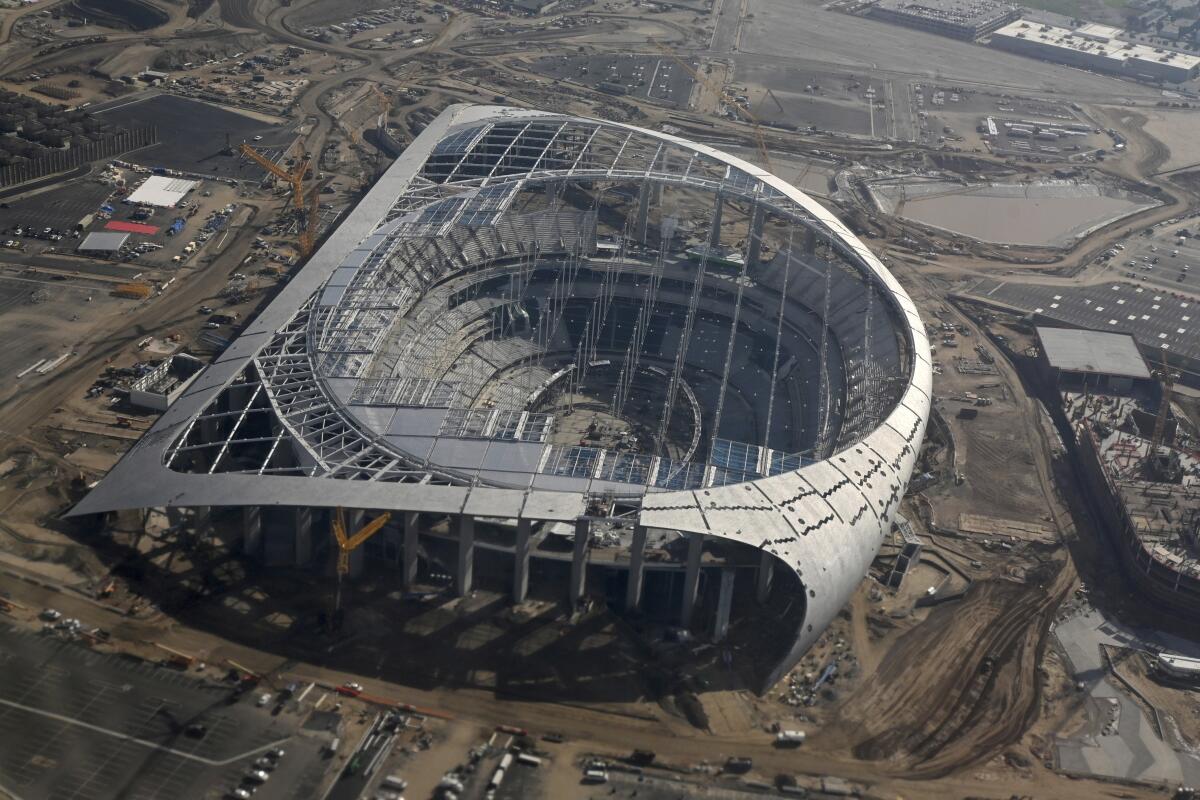
With Los Angeles International Airport only a few miles west, jets whizzing low on approach, Hollywood Park developers had to adjust.
They paid $29 million to install a secondary radar system, addressing FAA concerns about interference with navigation. The height of the stadium and construction cranes were another issue, so crews dug 100 feet into the earth, effectively burying half of the structure.
Fans arriving for games will enter at level five or six, depending on the gate; many will walk downstairs to their seats.
The subterranean design led to another issue because of the nearby Newport-Inglewood fault, one of Southern California’s top seismic danger zones. Workers made that big hole — more than eight million cubic yards’ worth of dirt — extra large and lined it with a “mechanically stabilized earth” wall. The stadium was set in the middle, leaving space all around so it could shake freely during an earthquake.
Follow along and ask questions as Arash Markazi interviews celebrities and players, hits up parties and checks out the best food ahead of Super Bowl LIV.
“It’s getting the benefits of a lot of design technologies … that are a little more exotic for a project of this size and scale,” said Alvin Huang, an associate professor of architecture at USC who is familiar with the project. He said the unusual steps were “the only way to do it.”
When Demoff hosted 17 members of the Rams Fan Council, which meets regularly with management to voice opinions and concerns, the group entered the site by shuttle bus, riding down a long tunnel to a cavernous, subterranean loading dock.
The Rams’ locker room is located down there, its walls curved like the logo on the team’s helmets. Asked about the Chargers’ space on other side of field, Demoff said: “It’s not a horn.” Instead, it has a conceptual lightning bolt implanted in the ceiling.
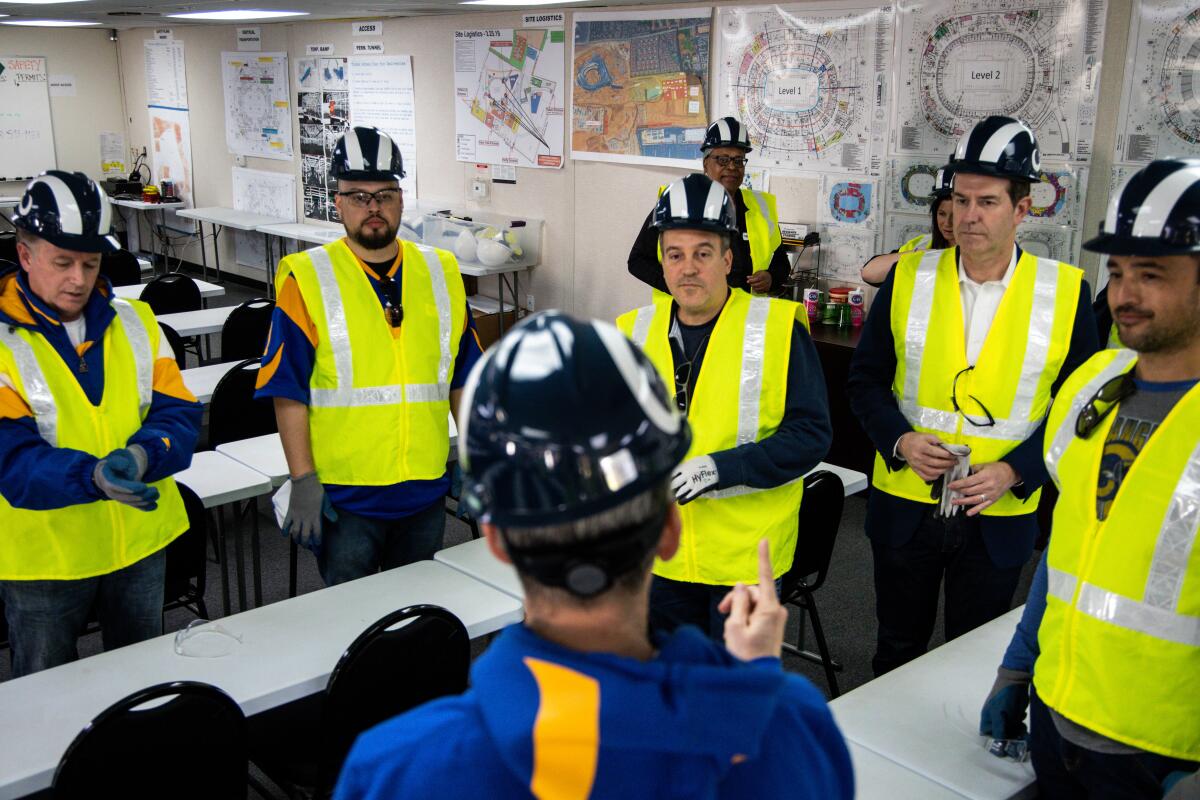
On the second level, plastic sheeting was pulled away so visitors could peer out from one of the 260 luxury suites. The Rams executive pointed to an immense contraption, black and oval like a bracelet, suspended over the field.
The Oculus video board stretches 120 yards long and 50 feet high, weighing more than two million pounds. With a capacity to display images on both its outside and inside surfaces, it aims to address a common question: Why should anyone attend an NFL game when television offers better coverage?
Demoff talked about showing highlights from around the league and replays from in-house skycams and pylon cameras. He said: “I can promise you, the number of cameras we have in the stadium is Super Bowl level.”
But there is something else about SoFi Stadium that impresses design experts more.
The venue comprises three distinct structures — the retaining wall lining that giant pit, the bowl and a vast canopy overhead, which stands on its own legs.
Crews have begun completing this last part, installing transparent ETFE panels on crisscrossed steel cables overhead. The roof will be open to ocean breezes around its edges; in a city passionate about its beaches and mountains, designers wanted to give fans a sensation of being outdoors while still protecting them from the elements.
“They’re going against the historic convention of stadium design where it is a closed roof or a retractable roof,” Huang said. “The span of that canopy is unreal.”
A network of LED lights will project images across the membrane, creating a vast movie screen. This works for both fans in their seats and airline passengers on arrival to LAX.
“You will literally have millions of people looking at it from above,” Huang said. “The roof not only becomes an architectural signature, it also becomes a branding signature.”
::
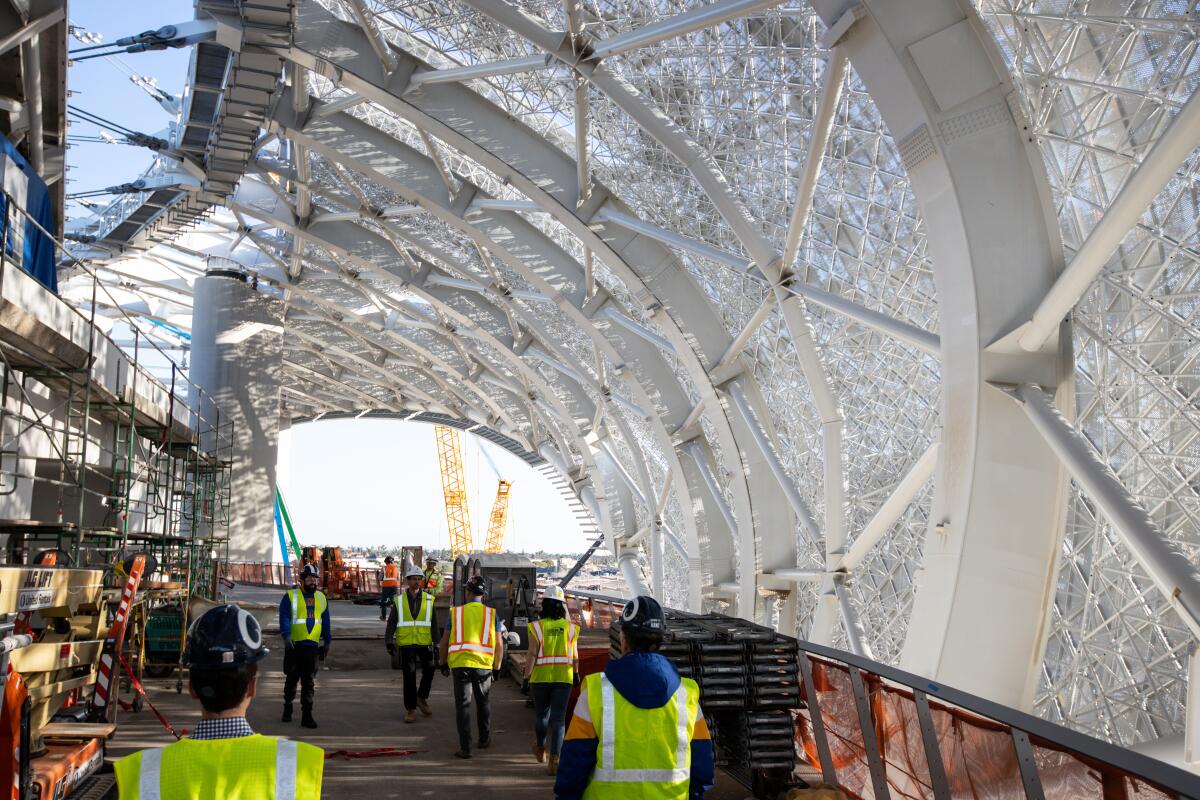
Plunged halfway underground, SoFi Stadium isn’t as visually intrusive as it might have been. It doesn’t seem as massive as AT&T Stadium in Arlington, Texas, which was similarly designed by HKS and serves as home to the Dallas Cowboys.
Still, from a distance, it looks like an alien craft touching down beside the Forum. And it will impact Inglewood in other ways.
Rams owner Stan Kroenke, a Missouri-born developer who made his fortune in shopping centers, is privately funding the project. He has called it a “huge, huge risk … because you’re doing something at a cost no one’s ever done before.”
Inglewood has reciprocated by offering tax breaks and reimbursements that could reach $100 million over time, but do not trigger until the venue generates $25 million in annual tax revenue.
Rick Eckstein, a Villanova University professor who has studied arenas and stadiums, calls this type of deal “a way to grease the skids without raising peoples’ dander.” He raises concerns about local commerce.
Though an Inglewood-based company has announced plans to open a brew pub at Hollywood Park, the development is likely to attract larger, national chains. That could bring unwanted competition for nearby mom-and-pop businesses.

He’s lived in his Inglewood apartment for 23 years. Then his rent doubled. Now, at 69, Major Stewart is moving into his family’s home.
“We saw this in Brooklyn around the Barclays Center,” Eckstein said of the arena for the Brooklyn Nets and New York Islanders. “If small-business owners are hitching their wagon to this, I think they might be disappointed.”
Mayor James T. Butts Jr. remains confident that Inglewood will benefit from the addition of Hollywood Park. He points to construction jobs created by the project and believes that small, existing businesses can thrive amid the arrival of larger ones.
With property values and rents already on the rise, and some residents worried about being priced out, the city has established a five-year rent control that, in most cases, will cap increases at 3%.
“One way to ensure that an area remains undesirable and to permanently have low wages and businesses that scrape by is to have high crime and poverty and low property values,” Butts said. “I find it fascinating that nobody worried about Inglewood when it was a high-poverty area and we had so many murders.”
But not everyone will be able to afford the games, with the Rams announcing season-ticket prices beginning at $60 a game and requiring a one-time seat license for $1,000 or more. Chargers games will be slightly less expensive, with licenses starting at $100 and seats at $50 a game.
::
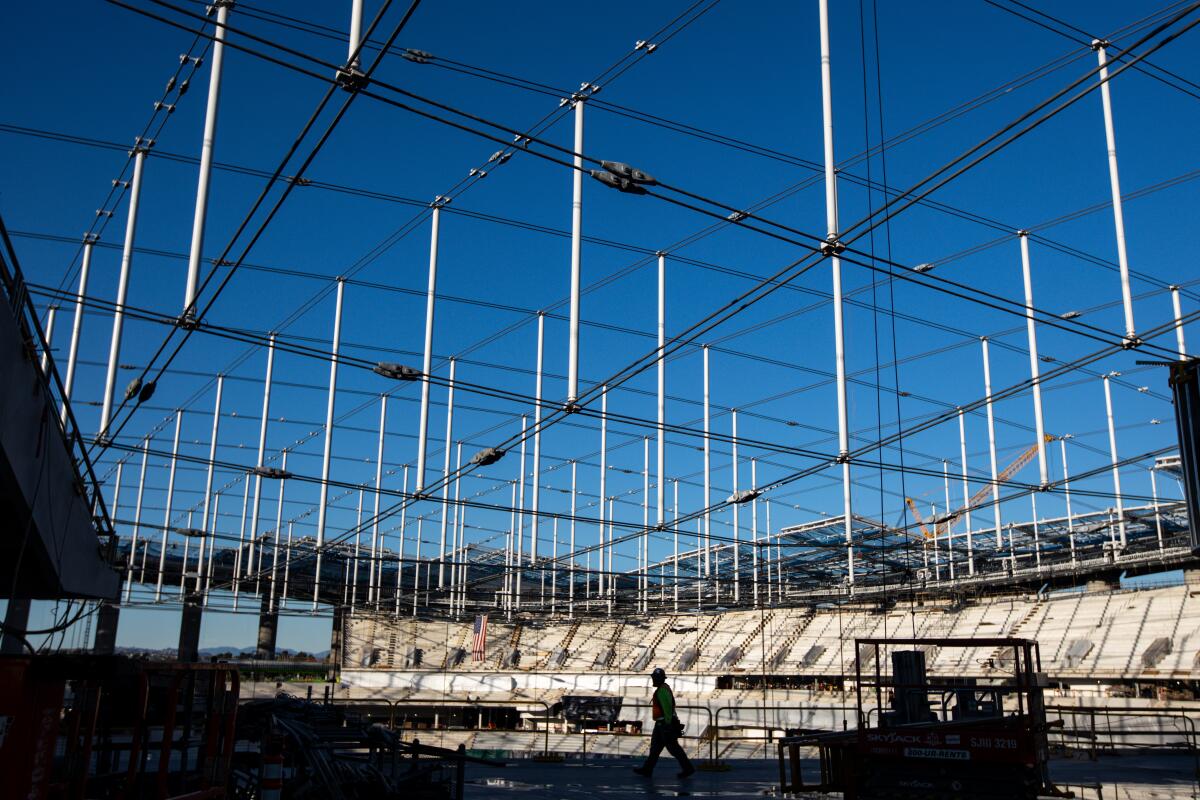
The construction at Hollywood Park isn’t limited to a stadium that has more than doubled in cost and been delayed by a year.
Workers buzz around a long, wing-like appendage that juts from the venue, housing an open-air plaza and a 6,000-seat performance theater. NFL Media is building a facility next door.
Standing at the railing on the eighth level, Demoff points south to a tiered lake that will serve as the centerpiece for 20 acres of adjoining parkland.
“Every decision we make,” he said, “has our fans in mind.”
But the physical elements of the stadium are merely a starting point for him. He talks about creating an atmosphere that extends beyond concrete, earth and steel.
The shape of the bowl and its canopy should make for a louder environment than at the Coliseum. He promises the fan council will have a say in the look of the venue.
Because SoFi will house two teams — as well as the 2022 Super Bowl, the 2023 college football national championship and concerts year-round — its interior is something of a blank slate, filled with digital surfaces that can be changed with a few clicks of a keyboard.
The die-hard Kansas City Chiefs fan known as “Bad Luck Chuck” kept his distance during the AFC championship. But he wants to see the Super Bowl in person.
The seats will always be blue, but the giant video board and screens throughout the venue can adapt to fit each situation.
“It was always designed to be very clean,” Demoff said.
The teams are still pondering exactly what that means for next fall.
The Chargers hired Pete Soto from Mercedes-Benz Stadium in Atlanta to oversee their programming. The Rams say they will draw upon the experience of playing at the Coliseum over the past four seasons, experimenting.
Along with that view from up high, it’s the part of his team’s new home that seems to get Demoff enthusiastic.
“The personal touches and how we make this building come to life on game day will be the differentiator,” he said. “How do we create this unbelievable atmosphere?”
More to Read
Go beyond the scoreboard
Get the latest on L.A.'s teams in the daily Sports Report newsletter.
You may occasionally receive promotional content from the Los Angeles Times.

